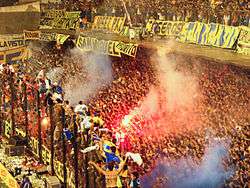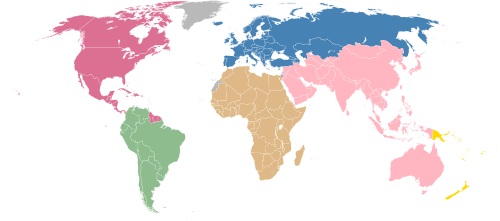Copa Sudamericana
The CONMEBOL Sudamericana, named as Copa Sudamericana (Spanish pronunciation: [ˈkopa suðameɾiˈkana]; Portuguese: Copa Sul-Americana [ˈkɔpɐ ˈsuw ɐmeɾiˈkɐnɐ]) is an annual international club football competition organized by CONMEBOL since 2002.[1] It is the second-most prestigious club competition in South American football. CONCACAF clubs were invited between 2004 and 2008.[2] The CONMEBOL Sudamericana began in 2002, replacing the separate competitions Copa Merconorte and Copa Mercosur (that had replaced Copa CONMEBOL) by a single competition.[1][2] Since its introduction, the competition has been a pure elimination tournament with the number of rounds and teams varying from year to year.
.svg.png) Current Copa Sudamericana official logo, in use since 2017 | |
| Founded | 2002 |
|---|---|
| Region | South America (CONMEBOL) |
| Number of teams | 47 (from 10 associations) |
| Qualifier for | Recopa Sudamericana Suruga Bank Championship |
| Related competitions | Copa Libertadores |
| Current champions | (1st title) |
| Most successful club(s) | (2 titles each) |
| Television broadcasters | List of broadcasters |
| Website | Official website |
The CONMEBOL Sudamericana is considered a merger of defunct tournaments such as the Copa CONMEBOL, Copa Mercosur and Copa Merconorte.[3][4][5][6] The winner of the Copa Sudamericana becomes eligible to play in the Recopa Sudamericana.[7] They gain entry onto the next edition of the Copa Libertadores, South America's premier club competition, and also contest the J.League Cup / Copa Sudamericana Championship.
The reigning champion of the competition is Ecuadorian club Independiente del Valle, who defeated Argentine club Colón in the most recent final.
Argentine clubs have accumulated the most victories with eight while containing the largest number of different winning teams, with a total of six clubs having won the title. The cup has been won by 15 different clubs. Argentine clubs Boca Juniors and Independiente are the most successful clubs in the cup's history, having won the tournament twice, with Boca Juniors being the only one to achieve it back-to-back, in 2004 and 2005.
History

In 1992, the Copa CONMEBOL was an international football tournament created for South American clubs that did not qualify for the Copa Libertadores and Supercopa Sudamericana.[8] This tournament was discontinued in 1999 and replaced by the Copa Merconorte and Copa Mercosur. These tournaments started in 1998 but were discontinued in 2001.[9][10] A Pan-American club cup competition was intended, under the name of Copa Pan-Americana, but instead, the Copa Sudamericana was introduced in 2002 as a single-elimination tournament with the reigning Copa Mercosur champion, San Lorenzo.[11]
Format
Until 2016 the tournament comprised 47 teams in a knockout format, with the Argentine and Brazilian teams getting byes to the second round and the defending champions entering the competition in the round of 16.[12] Starting from the 2017 edition, the tournament implemented the following format changes:[13][14][15][16][17][18]
- The tournament was expanded from 47 to 54 teams.
- A total of 44 teams would directly enter the Copa Sudamericana, while a total of 10 teams eliminated from the Copa Libertadores (two best teams eliminated in the third stage of qualifying and eight third-placed teams in the group stage) would be transferred to the Copa Sudamericana, entering the competition in the second stage.[19]
- The schedule of the tournament was extended to year-round so it would start in February and conclude in December.
- As the Copa Libertadores and the Copa Sudamericana would be held concurrently, no team would be able to qualify for both tournaments in the same year (except those which were transferred from the Copa Libertadores to the Copa Sudamericana).
- The Copa Sudamericana champions would no longer directly qualify for the next edition as they would now directly qualify for the group stage of the Copa Libertadores (although they would still be able to defend their title if they finished third in the group stage).
- Brazil would be allocated six berths, decreased from eight.
- All teams directly entering the Copa Sudamericana would enter the first stage.[19]
Trophy
The tournament shares its name with the trophy, also called the Copa Sudamericana or simply la Sudamericana, which is awarded to the Copa Sudamericana winner.[20]
La Otra Mitad de La Gloria
La Otra Mitad de La Gloria (The other half of glory) is a promotional Spanish phrase used in the context of winning or attempting on winning the Copa Sudamericana.[21] It is a term widely used by Spanish-speaking media. The tournament itself has become highly regarded among its participants since its inception. In 2004, Cienciano's conquest of the trophy ignited a party across Peru.[22] The Mexican football federation regards Pachuca's victory in 2006 as the most important title won by any Mexican club.[23]
Sponsorship
Like the Copa Libertadores, the Copa Sudamericana was sponsored by a group of multinational corporations. Like the premier South American club football tournament forementioned, the competition used a single, main sponsor. The first major sponsor was Nissan Motors, who signed an 8-year contract with CONMEBOL in 2003.
However, the competition has had many secondary sponsors that invest in the tournament as well. Many of these sponsors are nationally based but have expanded to other nations. Nike supplies the official match ball, as they do for all other CONMEBOL competitions.[24] Embratel, a brand of Telmex, is the only telecommunications sponsor of the tournament.[25] Individual clubs may wear jerseys with advertising, even if such sponsors conflict with those of the Copa Sudamericana.[26]
As of May 2017, online entertainment site Bumbet has become a premium sponsor of Copa Sudamericana.[27]
Prize money
Clubs in the Copa Sudamericana receive $400,000 for qualifying for the competition. Afterwards, each club earns $90,000 per home match.[28] That amount is derived from television rights and stadium advertising.[28] In addition, CONMEBOL pays $500,000 to the winners.[28]
Media coverage
Starting 2019 season, DirecTV (Latin America, exclude Brazil) and DAZN (Brazil) broadcast the Copa and Recopa Sudamericana coverage until 2022 from the previous broadcaster, Fox Sports (Latin America) and the CONMEBOL Libertadores-Sudamericana broadcast package are separate.[29][30] RedeTV! (Brazil) will also broadcast the tournament.[31]
Records and statistics

Claudio Morel Rodríguez is the only player to have won three Copa Sudamericana winners' medals.[32]
As of the end of the 2014 tournament, LDU Quito and São Paulo have played most games in the tournament (50).[33]
Winners
| Team | Winners | Runners-up | Winning Years | Runners-up Years |
|---|---|---|---|---|
| 2 | — | 2004, 2005 | ||
| 2 | — | 2010, 2017 | ||
| 1 | 1 | 2009 | 2011 | |
| 1 | 1 | 2014 | 2003 | |
| 1 | — | 2002 | ||
| 1 | — | 2003 | ||
| 1 | — | 2006 | ||
| 1 | — | 2007 | ||
| 1 | — | 2008 | ||
| 1 | — | 2011 | ||
| 1 | — | 2012 | ||
| 1 | — | 2013 | ||
| 1 | — | 2015 | ||
| 1 | — | 2016 | ||
| 1 | — | 2018 | ||
| 1 | — | 2019 |
Winners by country
| Country | Wins |
|---|---|
| 8 | |
| 4 | |
| 2 | |
| 1 | |
| 1 | |
| 1 | |
| 1 | |
Source:[34]
References
- "SOUTH AMERICAN COMPETITIONS". rsssf.com. Retrieved 28 March 2010.
- "Nissan South American Cup". conmebol.com. Retrieved 28 March 2010.
- Historia de la Copa Conmebol en página oficial Conmebol.com
- Rsssf.com
- "Terra Brazil". Archived from the original on 2013-09-30. Retrieved 2013-07-07.
- Santander Fútbol
- "Recopa Sudamerica". CONMEBOL. Retrieved 28 March 2010.
- "Copa CONMEBOL". conmebol. Retrieved 28 March 2010.
- "Copa Merconorte". conmebol. Retrieved 28 March 2010.
- "Copa Mercosur". conmebol. Retrieved 28 March 2010.
- "Copa Pan-Americana 2003". RSSSF. Retrieved 28 March 2010.
- Karel Stokkermans (10 December 2015). "Copa Sudamericana 2015". RSSSF. Retrieved 4 July 2016.
- "Conmebol informa detalles adicionales sobre reforma de Copa Libertadores y Copa Sudamericana". CONMEBOL.com. 3 October 2016.
- "Conmebol ratifica calendario anual para Copa Libertadores y Copa Sudamericana". CONMEBOL.com. 3 October 2016.
- "Comunicado de CONMEBOL sobre torneos de clubes". CONMEBOL.com. 27 September 2016.
- "What to know about the significant changes and new format for the Copa Libertadores". CBS Sports. 27 September 2016.
- ""Invitación por criterio técnico": Boca y River podrían jugar la Copa Libertadores 2017". La Nacion. 27 September 2016.
- "La Libertadores tendrá más semanas y más equipos". El Sol de Mexico. 27 September 2016.
- "La Copa Sudamericana 2017 reunirá a 44 clubes". CONMEBOL.com. 6 December 2016.
- Agosto abre el noveno capítulo de un torneo que se hace mayor
- "Fiesta por la otra mitad de la gloria" (in Spanish). HOY. Archived from the original on 2011-09-27. Retrieved 2010-08-24.
- "Toda Peru festeja título de Cienciano" (in Spanish). Fútbol Peru. Archived from the original on May 17, 2010. Retrieved August 5, 2010.
- "Historia del Club Pachuca" (in Spanish). Federación Mexicana de Fútbol Asociación. Archived from the original on 2012-03-24. Retrieved August 5, 2010.
- "Nike presentó la nueva pelota para el Torneo" (in Spanish). Info Bae. 13 January 2010. Archived from the original on 7 October 2012. Retrieved 12 January 2010.
- "Image of the 2010 Copa Sudamericana draw with its sponsors clearly represented". Caracas Futbol Club. March 9, 2006. Archived from the original on August 13, 2011. Retrieved May 18, 2010.
- "Reglamento de la Copa Nissan Sudamericana de Clubes 2010" (PDF) (in Spanish). CONMEBOL. April 28, 2010. Archived from the original (PDF) on October 10, 2010. Retrieved May 18, 2010.
- "Bumbet Nuevo Sponsor Premium de la CONMEBOL SUDAMERICANA 2017 Y 2018 | Conmebol.com". conmebol.com (in Spanish). Retrieved 2017-05-10.
- "Copa Sudamericana: Goias e Independiente juegan la final. U$ 5.000.000 en disputa". Impulso. December 2, 2010. Archived from the original on December 4, 2010. Retrieved December 2, 2010.
- "DAZN TO LAUNCH SPORTS STREAMING SERVICE IN BRAZIL". DAZN Media Centre. 2018-11-29. Retrieved 2018-12-27.
- "DAZN, SporTV and DirecTV secure Copa Libertadores rights". www.sportspromedia.com. Retrieved 2018-12-27.
- "RedeTV! transmite ao vivo Racing x Corinthians às 21h30 desta quarta-feira (27)". RedeTV! (in Portuguese). Retrieved 2019-02-24.
- "Claudio Morel Rodríguez". Boca Juniors. Archived from the original on 2010-06-25. Retrieved 2010-07-02.
- "Historical table". RSSSF. Retrieved 4 July 2016.
- Karel Stokkermans (23 December 2015). "Copa Sudamericana". RSSSF. Retrieved 21 February 2016.
External links
| Wikimedia Commons has media related to Copa Sudamericana. |
- Copa Sudamericana Regulations 2014 (in Spanish)
- Official Facebook (in Spanish)
- Official Twitter (in Spanish)
- Copa Sudamericana results at RSSSF.com
- Copa Sudamericana at worldfootball.net
